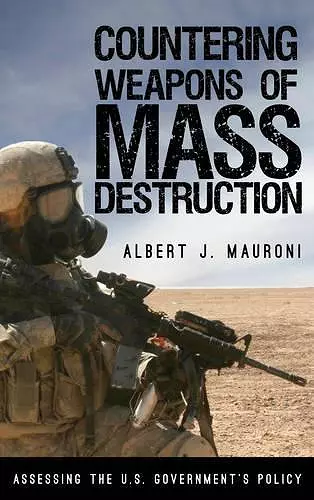Countering Weapons of Mass Destruction
Assessing the U.S. Government's Policy
Format:Hardback
Publisher:Rowman & Littlefield
Published:18th Oct '16
Currently unavailable, and unfortunately no date known when it will be back

The Cold War phrase “weapons of mass destruction” continues to be used despite significant changes in international political cultures, military concepts of operation, and technology advances. Today, the term “weapons of mass destruction” (WMD) is used to address many things, from grams of ricin and barrels of industrial chemicals to megaton nuclear weapons. As a direct result of the decision to refer to all nuclear, biological, and chemical (NBC) weapons as well as biological, chemical and radiological (CBR) hazards as “WMD,” we have lost the ability to accurately develop, assess, and discuss policy concerns relating to the contemporary use of unconventional weapons on the battlefield and within the homeland. This book uses a public policy framework to examine how the U.S. government, and in particular the U.S. military, should address the potential use of unconventional weapons in the 21st century. It defines the problem, identifies the policy actors and reviews policy options. It discusses past policy efforts before offering a critical review of current strategies and how WMD issues are integrated into the current military Joint Operating Concepts (deterrence, cooperative security, major combat operations, irregular warfare, stability, and homeland security), and proposes new national framework for countering WMD. The aim is to answer such questions as what does counterproliferation mean and whether the U.S. government is adequately prepared to protect U.S. citizens and its armed forces from adversaries developing unconventional weapons.
Is the U.S. government prepared for WMD use by hostile actors against either the homeland or its military forces abroad? In considering the effectiveness of its multiple counter-WMD efforts, Mauroni identifies important problems with the government's conceptualization of weapons of mass destruction that lead to poor threat assessment and feeble prioritization among response efforts. Mauroni urges consideration of the strategic similarities and differences among nuclear, radiological, chemical, and biological weapons. His prescription for improving the U.S. response to the threats they pose is measured and thoughtful. This book will spark valuable debate and soul searching. -- Jill Hazelton, Professor, Department of Strategy and Policy, U.S. Naval War College
A comprehensive, illuminating, and hard-hitting treatment of how the United States can better understand and counter weapons of mass destruction threats from an experienced expert. -- Elbridge Colby, Robert M. Gates Senior Fellow, Center for a New American Security.
Brilliantly assesses the gaps between the WMD threat and the resources DOD devotes to it. A splash of cold water and clarion call for the policy community to take a new look at countering WMD from a perspective that may well be able to adequately address it. Superb review and historical tour de force of contemporary WMD policy, budget, and planning processes for countering WMD. Passionately argues for clarity in defining the very term “WMD” and in policy direction and agency oversight for this vital matter where multiple agencies often work towards the same end, but with little coordination. -- David S. Jonas, Partner, FH+H Firm, a DC area national security law firm, former General Counsel of NNSA, and Adjunct Professor at Georgetown and George Washington University Law Schools.
ISBN: 9781442273290
Dimensions: 238mm x 161mm x 26mm
Weight: 594g
320 pages